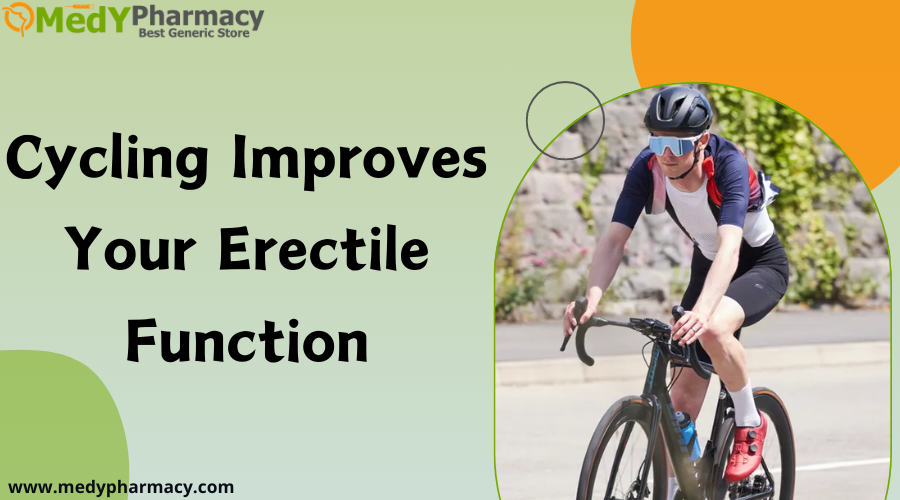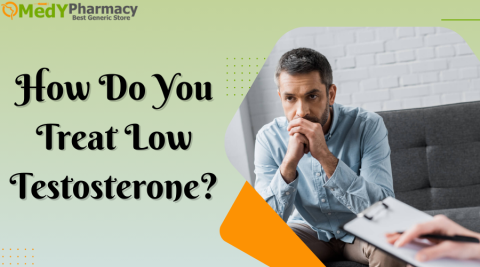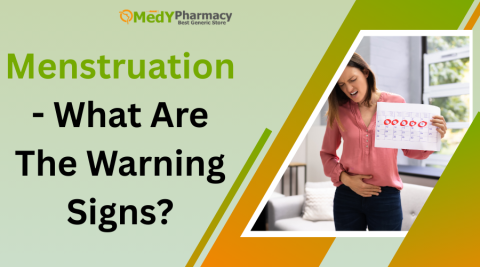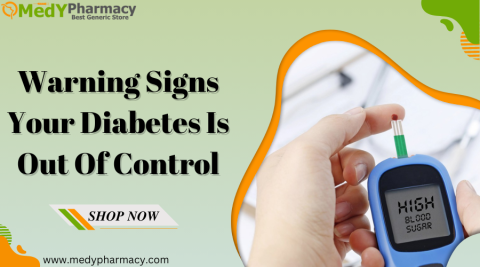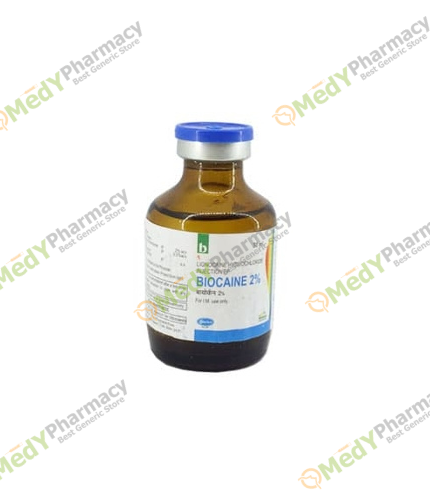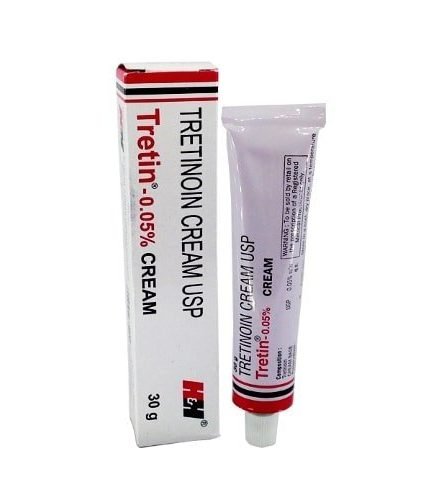Introduction:
Cycling is a popular aerobic exercise activity that burns calories and strengthens the leg muscles. However, those with a penis who ride bikes may encounter erection problems as an unintentional consequence of spending too much time on a bike seat.
Here’s why riding a bike can impair your capacity to achieve an erection, as well as how to keep cycling from jeopardizing your sex life.
However, those with a penis who ride bikes may encounter erection problems as an unintentional consequence of spending too much time on a bike seat.
How does cycling influence erections?
When you sit on a bike for an extended amount of time, the seat places pressure on your perineum, which runs between your anus and penis. The perineum contains arteries and nerves that deliver oxygenated blood and feeling to your penis.
Nerve impulses from the brain deliver arousal messages to the penis. These nerve signals cause blood vessels to relax, boosting blood flow from the arteries to the penis.
Any problem with the nerves, blood vessels, or both can prevent you from having an erection. This is referred to as erectile dysfunction (ED).
Over the last few decades, experts have discovered that some male cyclists suffer damage to the pudendal nerve, the major nerve in the perineum, and the pudendal artery, which transports blood to the penis.
Men who spend a lot of time on their bikes have reported numbness and difficulty achieving an erection. Experts believe ED begins when arteries and nerves become trapped between the tight bicycle seat and the rider’s pelvic bones.
Why is cycling said to cause ED?
According to the American National Institutes of Health (NIH), one theory is that long-term bicycling exerts pressure on the pudendal nerve, which transmits impulses between the genitals and the brain. When sitting on a rigid, narrow bike seat for a lengthy amount of time, nerve compression can interfere with communication between the brain and the genitals, resulting in diminished sensation and, on rare occasions, ED.
Another notion is that constant pressure on the perineum momentarily reduces blood and oxygen supply to the penis, which may eventually lead to ED.
In rare situations, a perineal injury might damage a penile blood artery, resulting in a prolonged partial erection (for hours or days). This disorder is known as priapism and necessitates rapid medical attention. Priapism is related to a risk of erectile dysfunction.
How Does Cycling Affect Erectile Function?
Cycling is a terrific way to stay physically healthy, move from A to B, and look cool. But is this kind of activity helpful or bad for erectile function?
Regular cycling has been identified as an independent risk factor for a variety of urological disorders.
- Pudendal nerve compression
- Numbness of the genitals
- Hematuria (bloody urine)
- Prostate inflammation
- Urologic cancers
Most urologists believe that allowing free blood flow to the penis is helpful. They also agree that frequent bicycle riding for exercise provides more significant health benefits for men in general.
How to Reduce the Risk of ED
With a few tweaks, you can still ride for exercise and enjoyment without jeopardizing your romantic life.
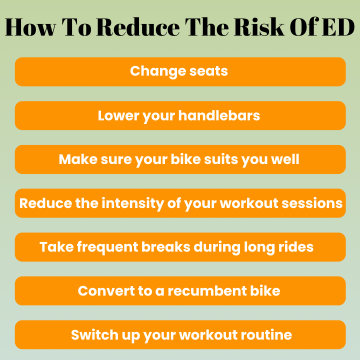
- Change seats: Replace your tight bicycle seat with one that is wider and has extra padding to support your perineum. To ease the pressure, use a seat without a nose.
- Lower your handlebars: Leaning forward will elevate your backside off the seat, relieving strain on the perineum.
- Make sure to wear padded cycling shorts: This will provide you with an additional layer of protection.
- Reduce the intensity of your workout sessions: Cycling for fewer hours at a time.
- Take frequent breaks during long rides: Walkabout or stand on the pedals at regular intervals.
- Convert to a recumbent bike: If you’re going to be riding your bike for a long period, reclining is better for your perineum.
- Switch up your workout routine: Instead of riding entirely, alternate between walking, swimming, and other forms of aerobic activity. Make cycling a part of your overall fitness plan.
Cycling leads to genital pain and numbness
Those who had vaginal numbness were more likely to report erectile dysfunction. The speed with which men reported numbness raised their likelihood of erectile dysfunction.
For example, if individuals experienced penile numbness or genital pain within an hour after cycling, they were more likely to develop Kamagra Polo. However, if individuals began to feel numbness five hours after cycling, they were less likely to develop ED.
The study concluded that, while there is insufficient evidence to link cycling to ED, it is not a bad idea to lessen pelvic discomfort, which may reduce the likelihood of sexual dysfunction.
Certain bike seats and riding styles decrease blood flow
Saddle designs and riding patterns that placed more pressure on the perineum resulted in lower penile blood flow and oxygen pressure. In some cases, perineal and vaginal numbness became more severe.
Another study in the review revealed that a small saddle lowered penile blood flow by 84% while a wide saddle reduced it by only 19%
The researchers concluded that utilizing a different bike seat or riding technique can reduce men’s risk of perineal numbness—and potentially ED. They recommend no-nose saddles, riding in a reclined position, and even standing on the pedals every 10 minutes.
The Mechanisms of Cycling and Its Possible Impact
Cycling requires sitting on a saddle, which can cause pressure on the perineal area. This area contains neurons and blood arteries that are necessary for erectile function. Concerns have been raised that continuous pressure may cause nerve and vascular damage, potentially leading to ED.
Pressure in the pelvic area
The saddle of a bicycle supports the majority of the rider’s weight, especially when riding for long periods. Persistent pressure on the perineum might crush nerves and blood vessels.
This compression can cause a transient decrease in blood flow and nerve function, potentially causing numbness and discomfort. Repeated and sustained pressure may cause more serious problems, such as Sildenafil.
What sexual benefits does cycling provide?
Cycling should not interfere with your sex life if you do not cycle hundreds of miles per week.
- Improving heart health and reducing the risk
- Lowering blood pressure and regulating blood sugar can reduce the risk of developing type 2 diabetes.
- Assisting you in reducing your weight and body fat
- Reducing your risk of contracting some malignancies.
- Improving your sleep quality
- Enhancing your emotional and mental wellbeing
- Increasing leg muscle mass and strengthening ligaments, tendons, and bones
What to do if you have an ED?
Cycling-induced ED and numbness might linger for several weeks or months, however they are rarely permanent. The simple solution is to reduce or eliminate bike trips.
If you’re still having difficulties getting an erection after many months, consult your primary care doctor or urologist. Other possible reasons for ED include a medical condition such as heart disease, a nerve problem, or the remaining effects of surgery.
- Sildenafil (Viagra)
- Tadalafil (Cialis)
- Vardenafil (Levitra)
ED medications are not indicated for persons who take nitrates (nitroglycerin) for chest pain, as well as those who have extremely low or high blood pressure, liver disease, or kidney disease. There are other medications available to treat ED, as well as non-drug options including penis pumps and implants.
Tips for male cyclists
While additional data is needed to confirm a link between cycling and ED, taking some measures is not a bad idea.
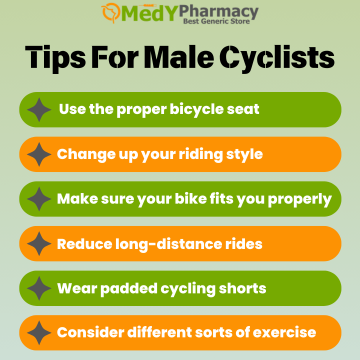
- Use the proper bicycle seat:
No-nose saddles (also known as cutout saddles) alleviate pressure on your perineum by leaving space between you and the seat. You can also choose a wide seat versus a narrow one.
- Change up your riding style:
Consider riding a recumbent bike in a reclined position or standing on the pedals to ease the pressure.
- Make sure your bike suits you well:
To ride comfortably, you must adjust your bike to fit your body. Aside from using the correct seat, make sure your handlebars are not too high. The incorrect handlebar height may cause you to overextend and put additional strain on your genitals and perineum.
You should also ensure that your seat is at the proper height. If you have to reach too low for the pedals, you put yourself at risk of developing pressure.
- Reduce long-distance rides:
The longer you ride, the larger the risk. Keep your rides brief or take multiple breaks on longer trips to give yourself a break.
- Wear padded cycling shorts:
Padded bike shorts provide greater protection and cushioning between you and your bike seat.
- Consider different sorts of exercise:
You shouldn’t have to give up anything you enjoy, but if you’re having trouble, you might want to reduce your intake. Swimming, jogging, and rowing are other low-impact aerobic exercises that won’t put you under too much stress.
Treatments for ED
Beyond adjusting your bike seat and riding style, if you’re having difficulties getting and staying hard, consider ED therapies. They include the following:
Therapy: Many males with eating disorders, particularly younger men, have psychological causes. Sexual performance anxiety, sadness, and stress can all lead to Sildigra Pill. Talking to a therapist might help you determine whether your mental health is interfering with your sexual health. They can also assist you in devising techniques to enhance your sexual experience.
Healthy living choices: Improving your lifestyle can benefit your sexual health. To safeguard your erectile function and general health, eat a well-balanced diet, limit your alcohol use, and quit smoking.
Can cycling help your sexual health?
We’ve talked a lot about the dark side of cycling, which is debatable. But how about the nice stuff? Can cycling increase sexual function?
Cycling helps you stay fit. Obesity is a major contributing cause of erectile dysfunction. Cycling may reduce your risk of ED by increasing your aerobic activity and keeping you fit, assuming you follow the precautions we indicated above.
Cycling enhances mental health. Stress, despair, and anxiety may all contribute to psychological ED. Cycling is associated with less stress, greater overall health, and a higher quality of life.
Precautions to Reduce the Effect of Cycling on ED:
Choose a larger, more padded seat than a tighter, racing seat. Gel-filled and cushioned seats are also viable alternatives.
Try not to angle your seat upwards because it puts greater pressure on your sexual organs.
Keep an eye out for early warning signs of erectile dysfunction, such as numbness in your penis, and if the problem persists, see your doctor.
Your cycling habits may not be the core cause of your erectile dysfunction; instead, they may indicate other conditions such as heart disease, nerve problems, or diabetes.
Is it possible to lower testosterone through cycling?
So, is cycling bad for your testosterone? This has also been claimed as a means for cycling to cause ED. Some claim that cycling lowers testosterone levels, which can cause or contribute to erectile dysfunction. There is some evidence that high levels of endurance exercise, such as hours spent riding, can reduce testosterone levels.
But we’re talking about endurance athletes. Cycling is unlikely to affect testosterone levels in fit and healthy non-athletes. Exercise of any kind, whether sedentary or overweight, often raises testosterone levels.
Can cycling result in infertility?
There’s also a lot of discussion online concerning cycle sperm count concerns and how they can render you infertile. Typically, riding hurts your testicles, while wearing tight shorts warms them up and reduces sperm production.
And we know that increasing the warmth of the testicles lowers sperm production and quality. So it’s possible that riding for hours in tight shorts can impair a man’s fertility. The study above focuses on triathletes, who participate in one of the most physically demanding sports available.
Balancing the risks and benefits
While the potential relationship between riding and ED is worth investigating, it is critical to balance these concerns with the various benefits of cycling. Regular cycling has been shown to promote cardiovascular health, aid in weight loss, build muscles, and improve general well-being.
The cardiovascular advantages, in particular, can improve erectile function, as good blood flow is required to achieve and maintain an erection.
The link between regular cycles and erectile function is still a complex and somewhat contentious issue. While some research implies that continuous cycling may increase the risk of ED, others show no significant association.
Contact Medypharmacy to speak with one of our trained experts and obtain a free consultation to discuss your situation and potential treatments.







